《典范英语》(6-01)课件
- 格式:ppt
- 大小:4.36 MB
- 文档页数:13


1Lesson 1 The Power Cut1. Listen to the story and then read it with lots of expression.(听录音,然后有感情地朗读故事。
)2. Answer the questions. (根据故事回答问题。
)(1) What did Wilma want to do when the family was on holiday? Do you think it is a good idea?______________________________________________________(2) What did they do for fun when the power was off?______________________________________________________(3) In the end, what surprise did Dad give the children?______________________________________________________(4) Do you think the family enjoyed the holiday? Why?______________________________________________________3. Finish the paragraph.(补全段落。
)The family arrived at a cottage for a holiday. The children played inside. Suddenly, all the lights______________. “ ______________the power doesn’t ______________?” asked Chip. “We’ll have to ______________ ,” said Dad. Then they had supper______________. That night, Chip______________on the wall with his hands. Wilma shone a torch ______________.2How did I do?模仿: 遍朗读: 遍效果:签字:学生自评 家长评价 老师评价4. What will you do for fun if you have a power cut tonight? Imagine and write a story. (如果今晚停电,你会做什么有趣的事情?发挥想象力,写一 个故事。
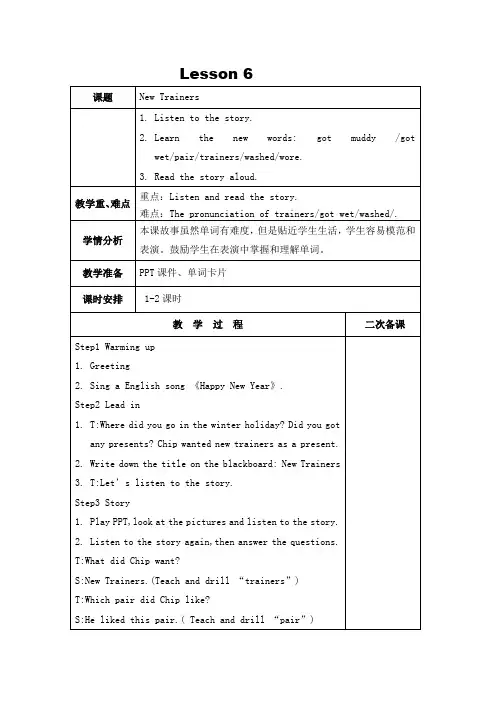
![典范英语 第六本 Jungle Shorts[优质PPT]](https://uimg.taocdn.com/72d90840551810a6f4248684.webp)
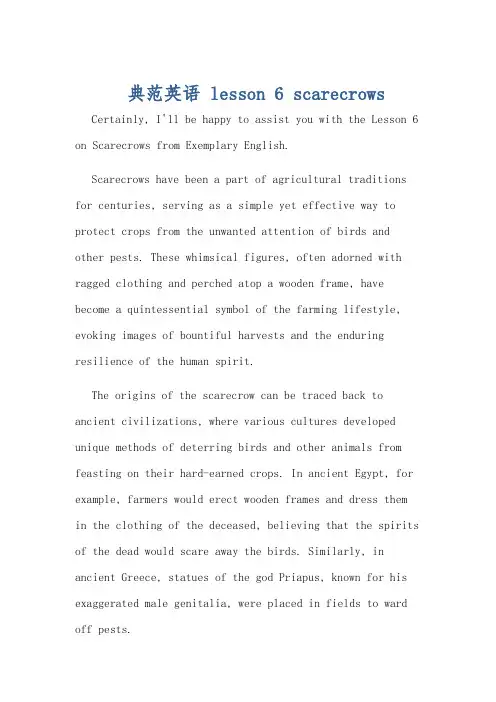
典范英语 lesson 6 scarecrows Certainly, I'll be happy to assist you with the Lesson 6 on Scarecrows from Exemplary English.Scarecrows have been a part of agricultural traditions for centuries, serving as a simple yet effective way to protect crops from the unwanted attention of birds and other pests. These whimsical figures, often adorned with ragged clothing and perched atop a wooden frame, have become a quintessential symbol of the farming lifestyle, evoking images of bountiful harvests and the enduring resilience of the human spirit.The origins of the scarecrow can be traced back to ancient civilizations, where various cultures developed unique methods of deterring birds and other animals from feasting on their hard-earned crops. In ancient Egypt, for example, farmers would erect wooden frames and dress them in the clothing of the deceased, believing that the spirits of the dead would scare away the birds. Similarly, in ancient Greece, statues of the god Priapus, known for his exaggerated male genitalia, were placed in fields to ward off pests.As agriculture evolved and spread across the globe, the scarecrow concept was adapted and refined by various cultures. In medieval Europe, farmers would often create elaborate scarecrows, dressing them in old clothes and positioning them strategically throughout their fields. These early scarecrows were not only functional but also served as a form of entertainment, with some villages even holding competitions to see who could create the most creative or amusing figure.The scarecrow's enduring popularity is a testament toits simplicity and effectiveness. By using a combination of visual and auditory cues, scarecrows are able to deter a wide range of avian pests, from the humble sparrow to the majestic crow. The flapping of clothing, the movement of the figure in the wind, and the occasional addition of noisemakers all contribute to the scarecrow's ability to scare away unwanted visitors.In modern times, the scarecrow has evolved beyond its practical applications and has become a beloved symbol of the harvest season. Scarecrow festivals and competitions are held in many rural communities, where people cometogether to celebrate the ingenuity and creativity of these humble guardians of the fields. From elaborate, life-sized figures to whimsical, child-sized creations, the scarecrow has become a cherished part of the autumn landscape.But the scarecrow's significance extends far beyond its agricultural roots. In literature and art, the scarecrow has been used as a metaphor for the human condition, representing themes of loneliness, vulnerability, and the search for identity. The Scarecrow in L. Frank Baum's "The Wizard of Oz," for example, is a poignant symbol of the quest for intelligence and self-discovery.Ultimately, the scarecrow stands as a testament to the enduring power of human ingenuity and the deep connection between humanity and the natural world. Whether serving as a practical tool for crop protection or as a symbol of our shared hopes and dreams, the scarecrow remains a beloved and enduring part of our cultural heritage.现在让我用中文回答这个问题。

《典范英语》(6a-L11)教学参考A Day in London教学参考的目的在于为实验课提供一个基本的思路和框架,帮助实验教师更好地把握课题理念。
课题组鼓励实验教师结合学生的实际情况适当做出调整,将实验课上出特色。
一、教学目标1. 语言能力目标:学生能够听懂录音;能够绘声绘色地独立朗读故事;能够理解故事情节;能够复述故事;能够围绕故事人物发表观点;复习已学的拼读规律;能够仿写故事。
2. 非语言能力目标:引导学生体验Gran和孩子们伦敦一日游的乐趣;增强学生的文化意识,让学生感受伦敦文化;通过情节分析和复述培养学生的总结概括能力;通过讨论培养学生的思辨能力和想象能力;培养学生大胆表达自己想法的自信和勇气。
二、课时安排每周不少于两课时,1-2个课时完成一个故事。
要求学生课前反复听录音跟读。
三、教师要求1. 教师课前须熟读故事,了解故事内容。
2. 对于较难的单词,教师可板书,并配合动作和表情帮助学生理解。
3. 全英文授课。
四、教学用具多媒体设备、CD机、课件(课题组提供)、词卡(square, squeeze, car, card, work, word)。
五、课堂教学基本步骤1. 导入(Lead-in):围绕“最喜欢的城市”展开讨论,引入故事通过展示图片和提问,激发学生兴趣,引出关于伦敦的讨论,为进入故事做铺垫。
(1)教师围绕最喜欢的城市这一话题提问:Which city do you like best?If you can spend a day in any city, where will you go?(2)教师展示有关伦敦地标性建筑的一系列图片,并与学生互动:Have you ever been to London?What do you know about London?之后,自然过渡到讲故事环节:Who came to see the children and spent a day in London with the children? Where did they go in London? Le t’s learn the story.2. 看图讲故事(Storytelling):了解伦敦一日行的前奏教师利用课件播放故事图片1-6,并用丰富的表情、生动的英文和适当的肢体语言给学生绘声绘色地讲故事,引导学生观察图片,了解Gran的性情和行为特点。

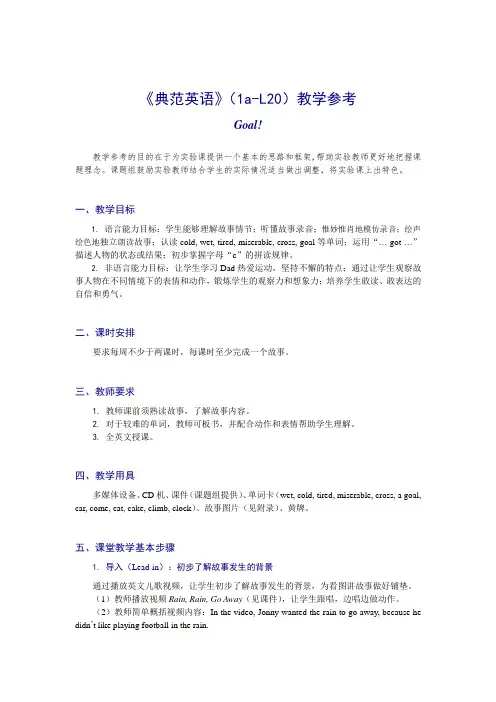
《典范英语》(1a-L20)教学参考Goal!教学参考的目的在于为实验课提供一个基本的思路和框架,帮助实验教师更好地把握课题理念。
课题组鼓励实验教师结合学生的实际情况适当做出调整,将实验课上出特色。
一、教学目标1. 语言能力目标:学生能够理解故事情节;听懂故事录音;惟妙惟肖地模仿录音;绘声绘色地独立朗读故事;认读cold, wet, tired, miserable, cross, goal等单词;运用“… got …”描述人物的状态或结果;初步掌握字母“c”的拼读规律。
2. 非语言能力目标:让学生学习Dad热爱运动,坚持不懈的特点;通过让学生观察故事人物在不同情境下的表情和动作,锻炼学生的观察力和想象力;培养学生敢读、敢表达的自信和勇气。
二、课时安排要求每周不少于两课时,每课时至少完成一个故事。
三、教师要求1. 教师课前须熟读故事,了解故事内容。
2.对于较难的单词,教师可板书,并配合动作和表情帮助学生理解。
3. 全英文授课。
四、教学用具多媒体设备、CD机、课件(课题组提供)、单词卡(wet, cold, tired, miserable, cross, a goal, car, come, cat, cake, climb, clock)、故事图片(见附录)、黄牌。
五、课堂教学基本步骤1. 导入(Lead-in):初步了解故事发生的背景通过播放英文儿歌视频,让学生初步了解故事发生的背景,为看图讲故事做好铺垫。
(1)教师播放视频Rain, Rain, Go Away(见课件),让学生跟唱,边唱边做动作。
(2)教师简单概括视频内容:In the video, Jonny wanted the rain to go away, because he didn’t like playing football in the rain.(3)教师提出问题,与学生互动:Do you like the rain?Do you like playing football in the rain?之后,进入故事情境:One day, Dad went to play football. Mum and the children watched. Did Dad play football in the rain? Let’s learn the story.2. 看图讲故事(Storytelling):理解故事情节,观察妈妈和孩子们在雨天观看爸爸踢球的情景教师利用课件逐幅播放故事图片,并用丰富的表情、生动的英文和适当的肢体语言给学生绘声绘色地讲故事,引导学生观察图片中的天气和家庭成员的表情动作,体会他们在雨中看爸爸踢足球时的心情。

《典范英语》(6b-L1)教学参考What Was It Like?教学参考的目的在于为实验课提供一个基本的思路和框架,帮助实验教师更好地把握课题理念。
课题组鼓励实验教师结合学生的实际情况适当做出调整,将实验课上出特色。
一、教学目标1. 语言能力目标:学生能够听懂录音;能够绘声绘色地独立朗读故事;能够理解故事情节;能够复述故事;能够用英语就故事主题发表观点;能够进行戏剧化地表演;能够正确拼读“bomb”;能够完成summary写作。
2. 非语言能力目标:引导学生体会战乱岁月的艰难,更加珍爱当下生活;能够置身故事情境,与故事人物感同身受;通过采访和讨论培养学生的思辨能力和想象能力;培养学生大胆表达自己想法的自信和勇气。
二、课时安排每周不少于两课时,1-2个课时完成一个故事。
要求学生课前反复听录音跟读。
三、教师要求1. 教师课前须熟读故事,了解故事内容。
2. 对于较难的单词,教师可板书,并配合动作和表情帮助学生理解。
3. 全英文授课。
四、教学用具多媒体设备、CD机、课件(课题组提供)。
五、课堂教学基本步骤1. 导入(Lead-in):了解战争,铺设故事情境通过声音、图片和问题加强学生对战争的了解,进入故事情境。
教师播放一段防空警报的音频(见课件),提问:What sound is this? (BQ:Is it a warning?)What do you think would happen? (BQ:Would there be a war?)教师展示有关战争的图片(见课件),引导学生感知战争带来的灾难:Could people live a happy life in a time of war?If you had to rehearse a war scene, would it be proper for you to laugh?学生回答后,过渡到看图讲故事环节:The children had to rehearse a play. What was the play about? Did the children do well? Let’s learn the story.2. 看图讲故事(Storytelling):了解历险背景教师利用课件播放故事图片1-8,并用丰富的表情、生动的英文和适当的肢体语言给学生绘声绘色地讲故事,引导学生观察图片,了解历险背景。
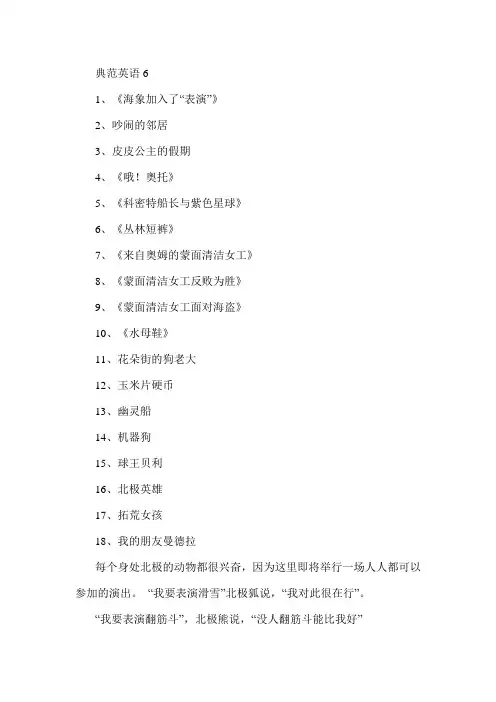
典范英语61、《海象加入了“表演”》2、吵闹的邻居3、皮皮公主的假期4、《哦!奥托》5、《科密特船长与紫色星球》6、《丛林短裤》7、《来自奥姆的蒙面清洁女工》8、《蒙面清洁女工反败为胜》9、《蒙面清洁女工面对海盗》10、《水母鞋》11、花朵街的狗老大12、玉米片硬币13、幽灵船14、机器狗15、球王贝利16、北极英雄17、拓荒女孩18、我的朋友曼德拉每个身处北极的动物都很兴奋,因为这里即将举行一场人人都可以参加的演出。
“我要表演滑雪”北极狐说,“我对此很在行”。
“我要表演翻筋斗”,北极熊说,“没人翻筋斗能比我好”“我唱歌吧”,海豹说,“每个人都说我嗓音很美。
“那我就表演潜水吧”鲸鱼说,“你们知道,我以前在学校可是拿过潜水奖牌的” 之后大家都看着海象,问他:你表演什么呢?但是海象什么都不擅长,既不会滑雪也不会翻筋斗。
他的歌唱的很糟糕,而他潜水时,鼻子也是露在水面上的。
于是海象难过的坐在那里,嚼他的胡子。
“没关系”,北极狐说,“你可以看我们表演啊”。
北极狐,北极熊,海豹和鲸鱼都在为那场大型远处而努力练习着,而海象却躲在一个雪堆后面边看着他们,边嚼着他的胡子。
他真希望自己能擅长些什么。
2。
盛大的夜晚终于,表演的盛大夜晚到来了,每个人都坐下来等待演出的开始。
还想坐在最前排,他很激动,狐狸走到冰上向大家示意,众人都欢呼着。
狐狸开始表演滑冰了,他时而前滑,时而后退,时而向两边滑去,他滑出一个优美的圆圈,并8字型的滑着,她的表演简直是无与伦比的完美,海象非常喜欢她的表演,狐狸表演这一切似乎都是那么的简单轻松。
海象认为如果自己也真正的去尝试,一定也能像狐狸表演的那么好。
海象情不自禁的跳到冰上和狐狸一起滑冰“我能滑冰了”他叫嚷着,“快,看我” 然而,海象并没能滑多久,他只是把一切搞砸,摔了一跤,他撞到狐狸,狐狸摔倒压在他的脸上,真糟糕!狐狸被他搞得心烦。
“海象搞砸了我的演出”狐狸悲叹说接下来,到了北极熊表演了,他蜷缩起来像一个雪球一样在冰面上滚动,众人都为他鼓掌,然后他就开始准备翻筋斗了,他又跳又滚,翻着筋斗,又倒立。
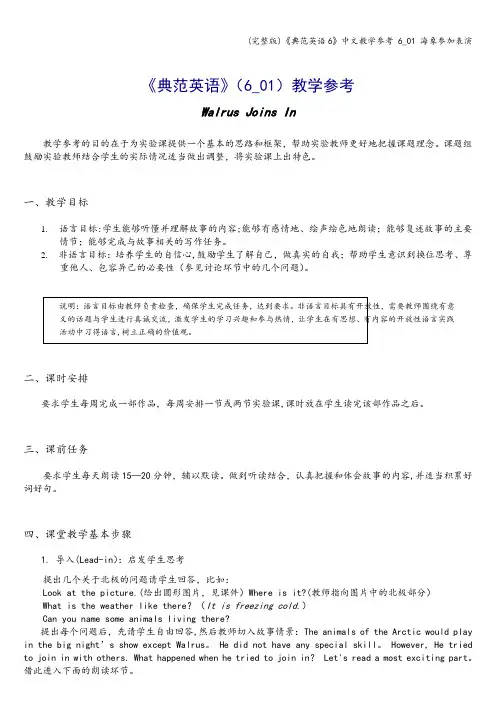
《典范英语》(6_01)教学参考Walrus Joins In教学参考的目的在于为实验课提供一个基本的思路和框架,帮助实验教师更好地把握课题理念。
课题组鼓励实验教师结合学生的实际情况适当做出调整,将实验课上出特色。
一、教学目标1.语言目标:学生能够听懂并理解故事的内容;能够有感情地、绘声绘色地朗读;能够复述故事的主要情节;能够完成与故事相关的写作任务。
2.非语言目标:培养学生的自信心,鼓励学生了解自己,做真实的自我;帮助学生意识到换位思考、尊重他人、包容异己的必要性(参见讨论环节中的几个问题)。
说明:语言目标由教师负责检查,确保学生完成任务,达到要求。
非语言目标具有开放性,需要教师围绕有意义的话题与学生进行真诚交流,激发学生的学习兴趣和参与热情,让学生在有思想、有内容的开放性语言实践活动中习得语言,树立正确的价值观。
二、课时安排要求学生每周完成一部作品,每周安排一节或两节实验课,课时放在学生读完该部作品之后。
三、课前任务要求学生每天朗读15—20分钟,辅以默读。
做到听读结合,认真把握和体会故事的内容,并适当积累好词好句。
四、课堂教学基本步骤1. 导入(Lead-in):启发学生思考提出几个关于北极的问题请学生回答,比如:Look at the picture.(给出圆形图片,见课件)Where is it?(教师指向图片中的北极部分)What is the weather like there?(It is freezing cold.)Can you name some animals living there?提出每个问题后,先请学生自由回答,然后教师切入故事情景:The animals of the Arctic would play in the big night’s show except Walrus。
He did not have any special skill。
However, He tried to join in with others. What happened when he tried to join in? Let's read a most exciting part。
《典范英语》(6b-L11)教学参考Rescue!教学参考的目的在于为实验课提供一个基本的思路和框架,帮助实验教师更好地把握课题理念。
课题组鼓励实验教师结合学生的实际情况适当做出调整,将实验课上出特色。
一、教学目标1. 语言能力目标:学生能够听懂录音;能够绘声绘色地独立朗读故事;能够理解故事情节;能够复述故事;能够用英语就故事主题发表观点;能够掌握字母组合“ou”的拼读规律;能够按照提示撰写故事前传。
2. 非语言能力目标:引导学生体会营救及脱险过程的惊险和刺激;感受故事人物的勇气、智慧及其临危不乱的镇定;通过讨论培养学生的分析能力和思辨能力;培养学生大胆表达自己想法的自信和勇气。
二、课时安排每周不少于两课时,1-2个课时完成一个故事。
要求学生课前反复听录音跟读。
三、教师要求1. 教师课前须熟读故事,了解故事内容。
2. 对于较难的单词,教师可板书,并配合动作和表情帮助学生理解。
3. 全英文授课。
四、教学用具多媒体设备、CD机、课件(课题组提供)、词卡(见拼读教学环节)。
五、课堂教学基本步骤1. 导入(Lead-in):猜测故事情节教师展示故事中出现的词语,让学生发挥想象力编故事,引出故事情境。
教师展示故事中的词语:bubble, chase, rescue, blow, run等,请学生即兴编故事,然后请学生展示,并过渡到讲故事环节。
2. 看图讲故事(Storytelling):了解历险背景教师利用课件播放故事图片1-6,并用丰富的表情、生动的英文和适当的肢体语言给学生绘声绘色地讲故事,引导学生观察图片,了解历险背景。
(Picture 1) Look! What were Wilf and Biff doing?They were blowing bubbles.What do you think of the bubbles? Were they small or big?“Wow! These bubbles are huge!” said Biff.Suddenly, the magic key began to glow. (指向发光的魔法钥匙)“Where will the magic take us this time?” said Wilf.(Picture 2)The magic took them to a flat rocky place. Can you see any trees in the place?No. There were no trees and all around them were high mountains.“Why has the magic key brought us here?” said Wilf.Suddenly they heard the sound of an aeroplane. (指向飞机)They both looked up. “I think it’s trying to land,”said Wilf.“It’s an odd place to land a plane,” said Biff. “I hope it can make it.”(Picture 3)The aeroplane came in very low. Then it bounced on the rough ground. “I think it’s going to crash,”said Wilf.Finally the plane stopped. But one of its wheels had been torn off. One of its wings had been ripped away.“I hope the pilot isn’t hurt,” gasped Biff.(Picture 4)The pilot climbed out of the wrecked plane. She looked at the torn-off wheel and broken wing. What did Wilf andBiff do?They raced up to the pilot.(Picture 5)The pilot took off her goggles. They know her. It was Princess Aisha. Why do you think Wilf and Biff knew her?They had met her before in another adventure.“Goodness,” said Aisha. “It’s you again.”“Why have you crashed?” asked Biff.“I didn’t mean to,”said Aisha. “My sister, Lisa, hasbeen kidnapped. I’ve come to rescue her.”(Picture 6)“Will you help me?” asked Aisha. “There’s no time to waste.”But they didn’t have a plane. “How will we do that?”asked Biff.“I’ll think of something,” said Aisha.What would they do to rescue Lisa?Did they get her away safely? (引入朗读环节)3. 朗读故事(Reading Dramatically):能够绘声绘色地朗读故事,朗读与理解相结合承接讲故事环节,引导学生带着问题去朗读,帮助学生理解故事。